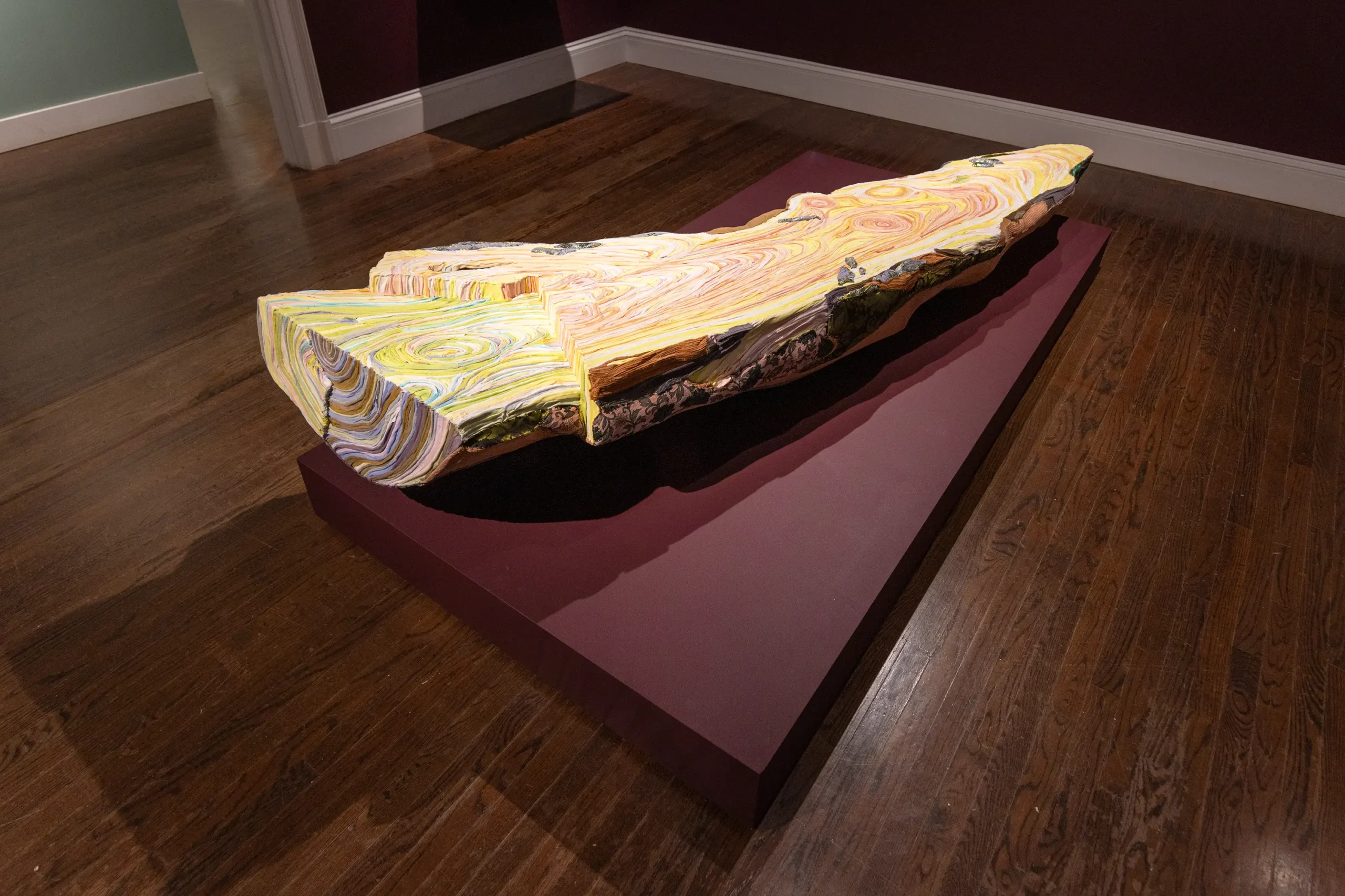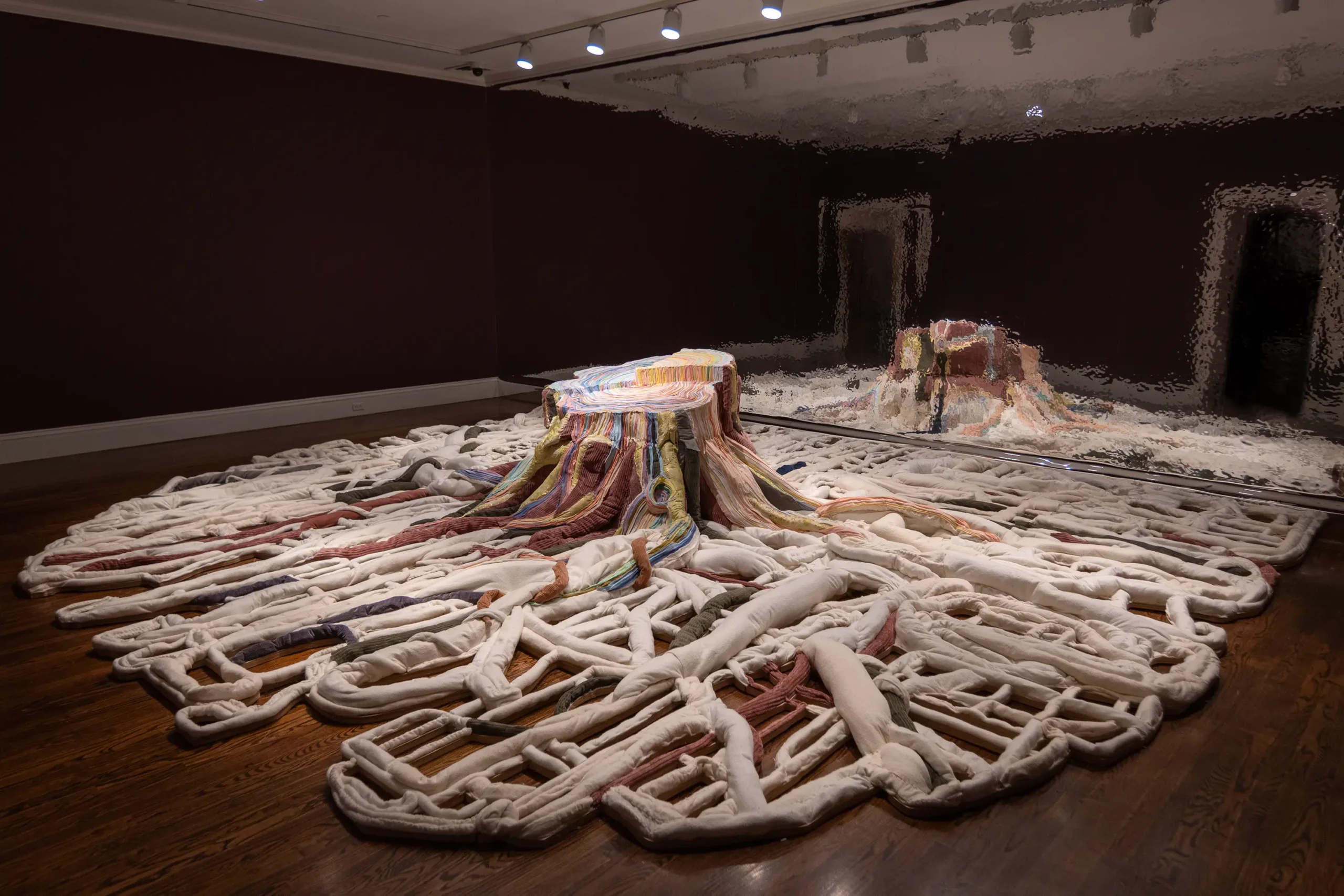Featured image: Narcissus by Tamara Kostianovsky at Cheekwood. Photo by Leo Sano.
Cheekwood’s 2025 Martin Shallenberger Artist-in-Residence explores analogies between nature and the human body through mixed-media sculptural installations constructed with repurposed textiles.
In conversation with Argentine American artist Tamara Kostianovsky, she explains that at the core of her work is an exploration of connections between the natural environment and human anatomy.
This is the central focus of, Narcissus, a large-scale sculptural installation that fills an entire gallery at Cheekwood. At the center of the enveloping creation is a tree stump, its fabric-woven root system stretching outward across the entire floor like limbs. The wall behind the sculpture is covered entirely in silver reflective Mylar, mirroring the scene back with a surreal effect.
The name “Narcissus” has origins in both botany and human nature: it’s the scientific name for the daffodil genus, and the name of a figure of vanity in Greek mythology, a man who fell in love with his own image reflected to him in a pool of water.
To create Narcissus the sculpture, Kostianovsky began by photographing dead trees in the forest. When she found a tree she liked, she built a true-to-scale sculptural tree form from plywood and armature wire. Next, she glued a high-resolution photograph of the origin tree to the face of her formed tree and traced the lines from the real tree onto her sculpture. Then she used a curved sewing needle to build a fabric surface with vibrantly colored strips of clothing and linens.
“It’s not that I’m making up the knots of the tree – I’m actually following the pattern that exists in nature,” Kostianovsky says.
Read on as Kostianovsky shares more ideas behind her exhibition at Cheekwood, her creative processes, and how an internship with a plastic surgeon led to her discovery of a fascinating world beneath the surface.
Artist-in-Residence: Tamara Kostianovsky is on view at Cheekwood through June 15.

Tamara Kostianovsky, Photographed by JC Cancedda. Courtesy of SLAG&RX Gallery and the artist.
How did you discover your passion of working with repurposed textiles?
I started working with textiles after learning about feminist women artists who used their own bodies in their work, particularly performance work in the ’70s and ’80s. I was inspired to include my body in the work and make work that was anti-patriarchal. Coming here from Argentina, I shrunk most of my clothes in the dryer and they were unusable. I started thinking of the clothing as a possible material to make sculpture, and in doing so, I realized there was more than just the anecdote to it, there was a political statement. I wasn’t purchasing art supplies, I was reusing things that would go into the landfill, and to a certain degree I was including my body in the work. I think clothing has an imprint of your body, it carries memories, it carries experiences and even dead cells, if you don’t wash it. So, it was an indirect type of performance in which my body was present without me literally being in the work.
You were a surgical intern when you were younger. How did this inspire your artwork?
When I was an art student, I started interning at a plastic surgical office, and it was there that I discovered a rich world right underneath the skin. The incisions that cut the skin revealed fat and veins that exploded into waterfalls and ligaments that set free the bones or the muscles they once contained. It was really an impressive visual experience. I tried to not think of it as, like, there's a person under all this, so that’s how I separated that. And then after participating passively in these operations, I would walk a few blocks and go to painting class. We were experimenting with oil colors at the time, so when I looked at red, it wasn’t just red, it was the color of blood I had just seen. And yellow was the color of fat. So, there was an immediate connection between human anatomy and painting, and that really became the source of my investigation very early on and I continue with that. To this day when I work with fabric, I think of it as if it’s skin. I try to make fabric have those layers of fat and tissue and flesh and blood. Somehow I became a participant in this tradition of artists that think of flesh as a subject, as an object. I’m proud to be part of that tradition.
What led you to create Narcissus?
"Narcissus" is a site-specific installation in which we see the stump of the tree and a very large and all-encompassing system of roots that take up a particular semi-circular shape to reveal almost like a network of connections, similar to the way that neurons align in the brain. Some of these sections of this network have geometric shapes to them and I was inspired to do that by seeing trees growing in urban environments in which oftentimes the woods try to circumvent the floor tiles or, you know, things on the ground that would have a more geometric orientation. The piece also may be reminiscent of a map of a city, so there is more than one connection that I hope people will be making when thinking about that.
Because it’s such a large artwork and you first worked with a smaller-scale model to plan it out, did it turn out how you imagined or did it kind of transform as you worked?
It turned out better than I imagined, and that’s a pleasant surprise. It was an ambitious work, and I have a small studio with very few people working alongside me. There's something that the space brought about, which is the actual nature of three-dimensionality, and when I work on this kind of scale or slightly smaller, I make a three-dimensional model. So, I knew what this was going to look like and that was planned, and the maquette is exhibited alongside with other works in the gallery next to us. But there was something about seeing the material in the space that really actualized here at Cheekwood.

Sunrise by Tamara Kostianovsky at Cheekwood. Photo by Leo Sano.
What were you thinking about while making Sunrise, and how did you approach it physically?
After my father passed away, like many of us who lose a loved one, I was thinking of what to do with his material possessions. Because I had been working with my own clothing at that time, I started thinking of using his clothing. My father spent the last few years of his life dedicated to gardening and he definitely had a green thumb – he would’ve loved it here at Cheekwood. I started making a group of new sculptures that I call “tree carcasses,” which are basically sculptures of dead trees that incorporate some of my father's corduroys, which were part of his signature style. That material lends itself really well to mimic the texture of tree bark. The trees are reminiscent of the color palette of human anatomy. There’s a lot of yellows and flashy colors. What I’m trying to do is create a type of analogy between the body of the tree and the body of a person, to a certain degree that I hope people will identify themselves in the body of the tree and therefore really know that it’s not really something outside of us, it’s the cloth we were all cut from. I thought of this sculpture as a type of memorial, not just for a loved one but also a memorial for the Earth and the trees that we use on a regular basis. You will see that in my artwork, there’s always a mechanical cut to the tree. So, it's not that the trees died in a storm or a lightning strike; it's really because somebody cut them. We can see here the hand of man in the separate planes running lengthwise of the tree. It’s never in one passing that the trees are cut, and that provokes the difference between the planes which I try to bring into my work. The top layer reveals the palette indicative of human anatomy. The shape of the tree itself is reminiscent of a coffin or body lying down or some sort of funeral procession.
Where did you source these specific pieces of fabric that you used?
Well, in here we have some of my father’s pants, in corduroy. We also have some remnants of brocades that I got my hands on through donation from a friend. And then most of the strips that you find in all my work really are kind of edging of the fabric. When fabric textiles are produced, they are sold in rolls and to make them straight, they cut off the edges. There’s a little strip that is usually discarded. I use that discarded material, so it’s already pre-cut, and it’s usually thrown away or goes into landfills. I like to think that I rescue that material, and I use it for my work.
Tell us a little about your piece at Cheekwood titled No Shadows in the Sky.
This is a textile panel, made on wood support and covered in textiles. This piece uses a very deep blue, very vibrant. A few years ago, I had an experience to travel to Naples, Florida, to do some research for an exhibition. I had access to seeing the fauna, the egrets, the alligators, and it was impressive just everything I saw there. But the one thing that stuck with me the most was the intensity of the blue sky and that is what inspired this color that is seen in the piece, which, I don’t think I have exaggerated. It was really this intense.

No Shadows in the Sky by Tamara Kostianovsky at Cheekwood. Photo by Leo Sano.
Are there any memories from your childhood in Argentina that appear in your work?
Before my experience in the plastic surgical office, the image that first got me interested in the arts or awakened an aesthetic experience for me was seeing the meat carcasses that are ubiquitous in Argentina. At the time, they were pretty much in every corner in every meat market. For Argentinians, meat is a source of pride and national identity. People gather around "asados". It’s a strong social aspect of our culture. I think the carcass itself, with the pinks and the reds, there’s something slightly morbid about it, but there’s something incredibly beautiful. Very early on, I also associated the silhouette of the carcass with the female form. So, for me there was a type of identification with it, with a dead body, I mean with the possibilities that can come out of that.
If your art had an odor, what would it smell like?
Do you know about the corpse flower? It’s a massive flower that has a kind of putrid smell, like flesh. That's why it's called the corpse flower. I like the idea of the juxtaposition of meat and flower, you know? That’s very much what I’m into [laughs].
